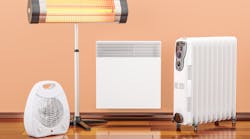So you know to keep combustibles away from stationary and portable heaters. But what about incombustibles? Heaters need a certain minimum air space around them, or they become a safety problem due to overheating.
If the heater does not specify air space on its label, look in the manual for that heater. That space includes the sides and rear; generally, you want at least 10 ft of space in front of a heater. The bigger the heater, the more likely you will need to increase the space. Keep portable cords out of that space; run them so they are not in front of heater grills or vents.
If a heater is fueled and ventilated, allow at least 18 in. around the chimney connector. And never place a heater on an unstable surface, on a combustible surface, or below combustibles. Never set anything on top of a heater, combustible or not.
Don’t use a space heater to warm food; it wasn’t designed for that purpose




